Press release
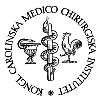
NOBELFÖRSAMLINGEN KAROLINSKA INSTITUTET
THE NOBEL ASSEMBLY AT THE KAROLINSKA INSTITUTE
The Nobel Assembly at the Karolinska Institute has today decided to award the Nobel Prize in Physiology or Medicine for 1988 jointly to
Sir James W. Black, Gertrude B. Elion and George H. Hitchings
for their discoveries of “important principles for drug treatment”.
Summary
The discoveries awarded with this year’s Nobel Prize in Physiology or Medicine concern important principles in drug treatment, principles that have resulted in the development of a series of new drugs.
Sir James W. Black realized the great pharmacotherapeutic potential of receptorblocking drugs and developed in 1964 the first clinically useful beta-receptorblocking drug, propranolol. This type of drug is now being used in the treatment of coronary heart disease (angina pectoris, myocardial infarction) and hypertension. In 1972 Black characterized a new group of histamine receptors, H2-receptors, and subsequently developed the first clinically useful H2-receptorantagonist, cimetidine. A new principle in the treatment of peptic ulcer was thereby introduced.
Gertrude Elion and George Hitchings, who have collaborated since 1945, demonstrated differences in nucleic acid metabolism between normal human cells, cancer cells, protozoa, bacteria and virus. On the basis of such differences a series of drugs were developed that block nucleic acid synthesis in cancer cells and noxious organisms without damaging the normal human cells. Over the years Elion’s and Hitchings’ research philosophy has formed the basis for development of new drugs against a variety of diseases. During 1950-51 they developed thioguanine and 6-mercaptopurine against leukemia and pyrimethamine against malaria. Azathioprine, a drug that prevents rejection of transplanted organs and allopurinol which is used in the treatment of gout were developed in 1957 and 1963, respectively. An important discovery was that the chemotherapeutic effects of pyrimethamine and trimethoprim were markedly enhanced by sulphonamides. A recent, successful application of their research ideas is exemplified by acyclovir (1977), the first effective drug in the treatment of herpes virus infections.
New Principles for Drug Treatment
The discoveries awarded with this year’s Nobel Prize in Physiology or Medicine concern the development of new drugs which have become essential in the treatment of a number of different disorders, mainly myocardial ischemia (angina pectoris), hypertension, gastroduodenal ulcer, leukemia, gout and infectious diseases. However, the research work carried out by Black, Elion and Hitchings has had a more fundamental significance. While drug development had earlier mainly been built on chemical modification of natural products they introduced a more rational approach based on the understanding of basic biochemical and physiological processes.
Black’s Discovery of Receptorselective Drugs
For a long time it remained unclear how the signal substances epinephrine and norepinephrine could exhibit a contractile as well as a relaxing effect on smooth muscle (Figure 1). The late American scientist Raymond Ahlqvist suggested already in 1948 that these apparently opposite effects of catecholamines were mediated by different receptors in the target organs, which he called alpha- and beta-receptors. Substances that selectively stimulate these receptors (agonists) were previously known as well as drugs that inhibit the effects mediated by alpha-receptors (antagonists).
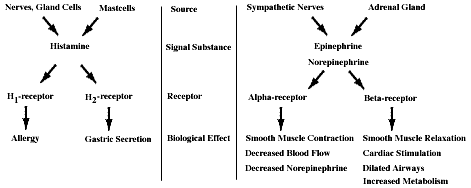 |
Figure 1. Receptor selective drugs block some effects of a signal substance leaving others unaltered. The figure shows how signal substances are released (source) and affect different receptor types. This leads to different biological effects. The H2-antagonists discovered by Black selectively inhibit gastric secretion, while beta-receptor antagonists inhibit cardiac and pulmonary actions of epinephrine and norepinephrine.
Ahlqvist’s receptor theory stimulated Black and coworkers to develop substances with beta-receptor blocking properties in a systematic way. Black was the first to realize that the development of a clinically useful beta-receptor blocking drug might introduce a new pharmacotherapeutic principle in the treatment of coronary heart disease (angina pectoris). Previously used drugs acted by increasing the oxygen transport to the heart. In contrast, Black’s idea was to decrease the oxygen demand of the heart by blocking the beta-receptors and thereby the workload of the heart. A beta-receptor blocking compound had been developed by other researchers in 1958, but it was only suitable for experimental studies in animals. Using the isoprenaline molecule as a basis Black and coworkers succeeded in developing the first clinically useful beta-receptor antagonists pronethalol (1962) and propranolol (1964).
The clinical trials of propranolol convincingly showed that Black’s ideas were correct, and beta-receptor blocking drugs have subsequently been widely used in the treatment of angina pectoris and conditions with tachycardia and tachyarrythmia. It was later found that these drugs were also effective in the treatment of hypertension and in decreasing the mortality in connection with myocardial infarction (Figure 2).
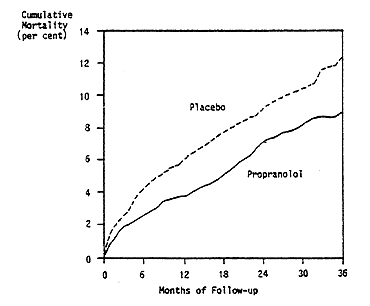
Figure 2. A large series of patients were treated with propranolol or placebo in order to reduce death following myocardial infarction. The mortality was significantly lower in the group treated with propranolol. From JAMA 1982, 247, 1707.
The development of propranolol has not only had a clinical importance but it has also initiated basic studies of the physiological role of beta-receptors. These receptors have subsequently been divided into two classes, beta1 and beta2, each of which can be influenced by different drugs.
Soon after the discovery of propranolol Black became interested in the effects of histamine, which only partly could be blocked by antihistamines known at the time. Thus, the stimulating effect of histamine on the secretion of gastric acid was not inhibited by these drugs. In analogy with what was then known about beta-receptors, Black suggested the occurrence of two types of histamine receptors, H1 and H2 (Figure l). While the former were blocked by the previously known antihistamines, there were no antagonists available for the H2-receptor mediated effects. Starting from the structure of the histamine molecule Black developed a series of substances which effectively blocked the H2-receptor mediated effects, in particular the secretion of gastric acid. In 1972 Black and coworkers for the first time defined the H2-receptors by using agonists and antagonists. One of the first synthesized substances, metiamide, was found to heal peptic ulcer but it produced agranulocytosis on rare occasions. Subsequently (1975) Black succeeded in developing another substance, cimetidine, which was found to have a marked effect in the treatment of peptic ulcer but without this side-effect.
Blocking of the H2-receptors introduced a new principle in the treatment of peptic ulcer, and a series of new drugs with the same mechanism or action has later been developed. As a consequence the need for surgical treatment of peptic ulcer has decreased significantly.
The development of selective H2-receptor antagonists has opened up new possibilities to explore the physiological role of the H2-receptors.
The clinical use of the principles for drug treatment discovered by Black are summarized in Table I.
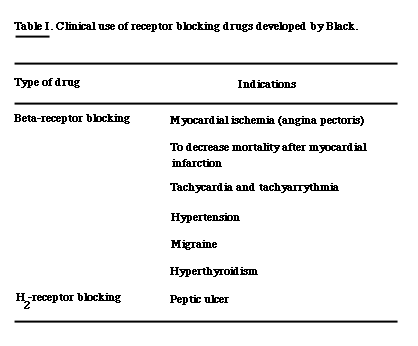 |
Studies of Nucleic Acid Synthesis Result in the Discovery of New Drugs
Gertrude Elion and George Hitchings have collaborated since 1945. Their original research idea was to look for differences in nucleic acid metabolism between normal human cells, cancer cells, protozoa, bacteria and virus, which could be utilized to develop drugs that selectively block the growth of cancer cells and of noxious organisms. Over the years this research philosophy has formed the basis for the development of drugs against a variety of disorders including leukemia, malaria, virus infections and gout.
When Elion and Hitchings presented their ideas at the end of the 1940s the knowledge about nucleic acid metabolism was very limited. It was known, however, that purines and pyrimidines are incorporated into nucleic acids. Elion and Hitchings studied the growth of the Lactobacillus casei, a bacterium dependent on folic acid or a combination of purines (hypoxanthine, guanine) and pyrimidines (thymine). The purpose was twofold, to characterize the metabolic pathways involved in the biosynthesis of nucleic acids and to identify antimetabolites in the nucleic acid metabolism (Figure 3).
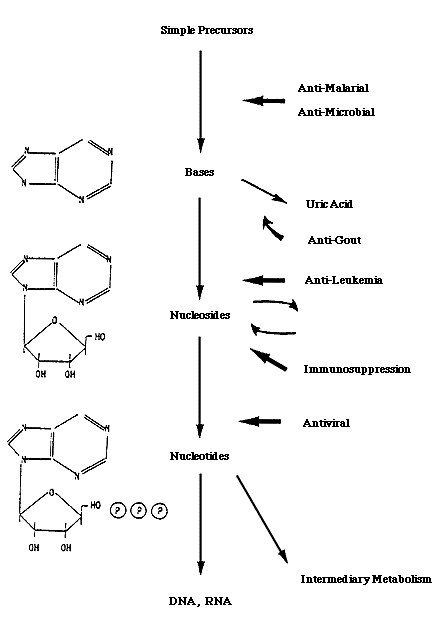
Figure 3. Purine bases (adenine, guanine and hypoxanthine) are synthesized from simple precursors. Nucleosides are then formed by the addition of sugar moieties (deoxyribose or ribose) and subsequently converted into nucleotides by the addition of phosphate (mono-, di- and triphosphate). Nucleotides take part in cellular metabolism and are the building blocks in the synthesis of RNA and DNA. Structural analogues of the natural substances can specifically block the different metabolic steps. Some examples are given in the figure.
Already in 1948 Elion and Hitchings discovered a substance, diaminopurine, an adenine antagonist, which inhibited the growth of L. casei (Figure 3). It was also found to have an effect on experimentally induced leukemia. Clinical trials in patients were initially promising but had to be interrupted due to toxic side effects. Stimulated by this finding Elion and Hitchings continued their research which soon resulted in two new chemotherapeutic drugs, thioguanine (1950) and 6-mercaptopurine (1951). In collaboration with the Sloan-Kettering Institute 6-mercaptopurine was tried in leukemic patients who were resistant to methotrexate. About one third of the patients responded with complete remission (1953). The finding was soon confirmed, and 6-mercaptopurine (as well as thioguanine) are still used in the treatment of leukemia (Table II).
Elion and Hitchings tried to improve the therapeutic properties of 6-mercaptopurine by using sulphur-substituted compounds. The result was azathioprine (1957) which replaced mercaptopurine as an inhibitor of the immune response. For a long time azathioprine was the only drug available to prevent rejection of transplanted organs. It is still used for that purpose but also for the treatment of autoimmune diseases.
Attempts were also made to prolong the effect of 6-mercaptopurine by blocking its metabolism by xanthine oxidase which is involved in the endogenous production of uric acid (Figure 3). In 1963 this research resulted in another new drug, allopurinol, which blocks the formation of uric acid and therefore is used in the treatment of primary and secondary gout.
Hitchings and collaborators also developed pyrimethamine (1950) and trimethoprim (1956) which were found to be effective in the treatment of malaria and bacterial infections, respectively. Both drugs have a strong affinity to the enzyme dihydrofolate reductase, but pyrimethamine is 2000 times more toxic to the enzyme system in the malaria parasite than in the host. Trimethoprim has 100 000 times higher affinity to the bacterial compared to the human enzyme. An important discovery was that the chemotherapeutic effects of these two compounds were markedly enhanced by sulphonamides, drugs which inhibit the synthesis of folic acid. This pharmacotherapeutic principle is used in the combination drugs trimethoprim-sulfa and pyrimethamine-sulfa which are used in the treatment of bacterial infections and malaria, respectively.
A more recent application of Elion’s and Hitchings’ research philosophy is acyclovir, a drug used in the treatment of infections with herpes virus. Already in the 1950s they had shown that antipurines had to be transformed into nucleotides in order to become active in the cell. The herpes virus carries information which leads to the production of a new enzyme which transforms nucleosides to nucleotides (thymidine kinase) in the infected cell. This enzyme has considerably less substrate specificity than the cell’s normal enzyme. Therefore, acyclovir is transformed into its corresponding nucleotide which is the active antimetabolite and the growth of the virus is inhibited (Figure 3).
Acyclovir was described by Elion and coworkers in 1977 and is a modern example of the realization of the basic ideas from 1950. An even more recent application of these ideas is the development of azidothymidine (AZT) which was described in 1985 by other scientists from the same institute, and which is the hitherto best documented drug in the treatment of AIDS. It can be added that trimethoprim-sulfa is used in the treatment of Pneumocystis carinii, a relatively common complication to AIDS.
The clinical use of the drugs discovered by Elion and Hitchings is summarized in Table II.
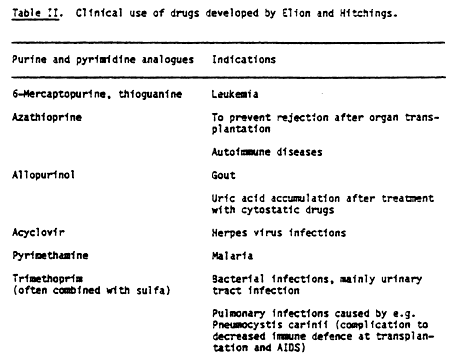 |
References
G. Gahrton, B. Lundh: Blodsjukdomar. Lärobok i hematologi. Natur och Kultur, Stockholm, 1983.
Läkemedelsboken 1987/88, Apoteksbolaget, Stockholm, sid, 87-88, 150-151, 249, 625.
J.H. Shelley: Creativity in Drug Research. Trends in Pharmacological Sciences. 1983, vol. 4.
L. Stryer: Biochemistry, 3rd edition. W.H. Freeman and Company, San Francisco, 1988, chapter 25, 601-625.
Nobel Prizes and laureates
Six prizes were awarded for achievements that have conferred the greatest benefit to humankind. The 12 laureates' work and discoveries range from proteins' structures and machine learning to fighting for a world free of nuclear weapons.
See them all presented here.
